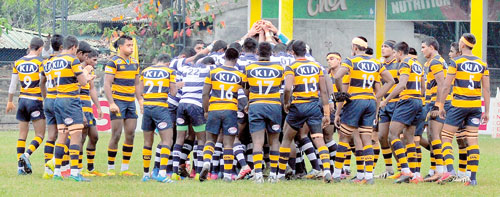The Greens proved a point but are Joes the new kids in town?
View(s):
Surrounded by the League champions, Royal during a first round game played months ago, the Josephians entered a major final for the first time - File pic
The Schools Rugby knockout started in 1978 and since then, it has been known by different names at various junctures. Hence, it has been known as the William Molegoda Trophy, The Premadasa Trophy etc and today it stands as the Milo Schools knockout for the President’s Trophy.
Walking to play St Peter’s in the semi-final, Isipathana was expecting their 22nd entry to the final of the 34 played to date. Every supporter expected the Green team to make it to the final. The unexpected could have happened, as it was Peters who spoilt their chances of a League victory.
Having to travel to unfamiliar terrain of Colombo North was not a task for the diehard Isipathana fan. They made their presence felt at the Sugathadasa Stadium.
Isipathana played with determination, running the ball but, as usual, making handling mistakes, costing the luxury of scoring. Peters on the other hand, looked dangerous, but made mistakes that cannot be fathomed. How can a team get penalised three times for numbers in a line-out is something I fail to understand. It was a close match and every decision did count. The game had its moments of indiscipline and the yellow cards thrown in at regular intervals, which took the steam out of both teams.
These yellow cards were handed out for acts of indiscretion and not major foul play. These, however, need to be understood and taught, as World Rugby gets tough, focusing a lot on player welfare. It definitely will be more distinct with the introduction of the 2017 laws of the game.
As we end this season, it must be understood that expectations will be high of teams that had always been on the top tier, but they cannot expect to win only on reputation. Other teams too are bound to improve.
Take the case of the other finalist St. Joseph’s who have been working to build on a Rugby culture from one where there has not been a tournament win in its history. Over the years, Joes have won and lost against major teams, but have not had a consistent winning record. Despite the odds of having had an average season behind them, they had a purpose to play for in the semi-final.
St. Joseph’s moulded themselves into a healthy unit and did well by convincingly beating Dharmaraja. The Rajans never looked like a team to be a challenge in the semi-final. After the match, some were wiping tears from their faces as they walked to congratulate the Joes players. These were tears of joy. The tears I saw in some were ones of happiness, probably because they were there to see a day St. Josephs entering a knockout-final. Last Saturday, past Captain Lakshitha Gunaratne, who is in the advisory committee, asked in a jubilant mood, whether I had written my column. By the time the semi-final was over the column had been submitted. Nevertheless, it was happiness that was in the faces of those supporting the Joes. Are Joes the new kids in the block? Is this win going to make a difference to the Rugby culture, by turning away from the history of no wins?
The two knock out semi-finals drew attention differently. For St. Joseph’s, it was because it is the first time they had an opportunity to enter a 15-a-side final in schools top Division Rugby. Labouring to be recognised, it got the opportunity. Hopefully, this is a step that will lead them into a tournament-winning future.
 For Pathana, it was defeating arch rivals St Peters who blunted the League title for the Park boys. By the time this column is read, the outcome of the final will be known.
For Pathana, it was defeating arch rivals St Peters who blunted the League title for the Park boys. By the time this column is read, the outcome of the final will be known.
The knockout has been won by Pathana, Royal, S.Thomas’, St Peter’s, Kingswood as well as Science College. Royal opted out in 2017, while Kingswood, S.Thomas’ and Science College did not make the eight.
There were cries of the stadium being out of the way. But the crowds did not let the schools down. They supported. The stadium being in the process of construction, in future it will be able to offer facilities such as a place to buy a bottle of water. The ambiance, some think, gives a caged feeling, which, I think, can be improved, if the organisers outsource the supply of food and beverage.
The grumbling was overpowering when the AR gave the throw to the side that took out the ball that was in movement. That was the law in 2016, when, in simple terms, the collector helps the kicker’s ball to cross the plane of touch. In 2017, this is changed and we are back to taking the ball out whether stationary or in motion – the responsibility for taking out is with the man collecting it, if at the time of collection, the ball has not passed the plane of touch. Simple as it seems, the law is not easy, other than when you are in the pavilion.
Vimal Perera is a former Rugby Referee, coach and Accredited Referees Evaluator IRB


